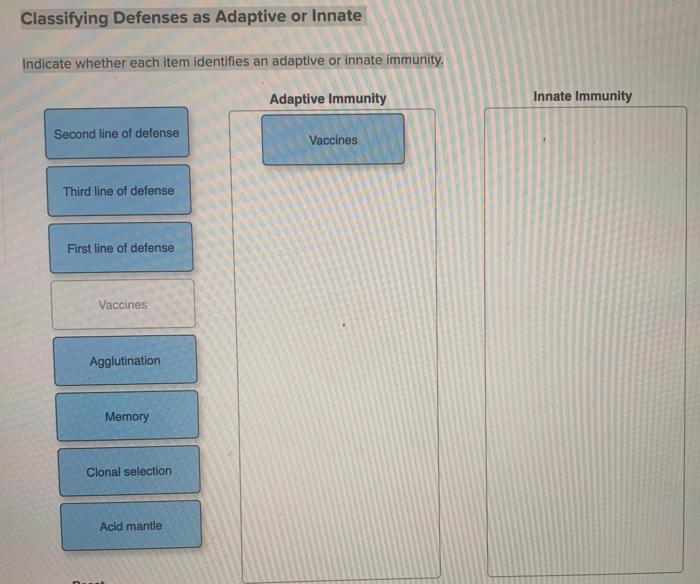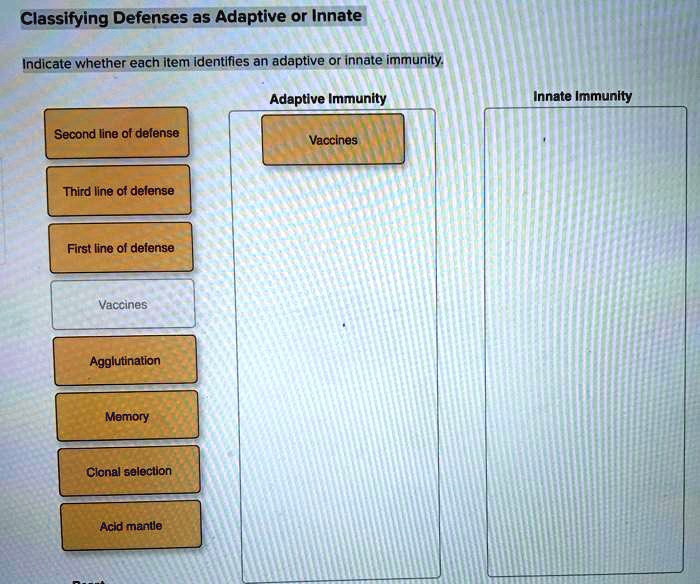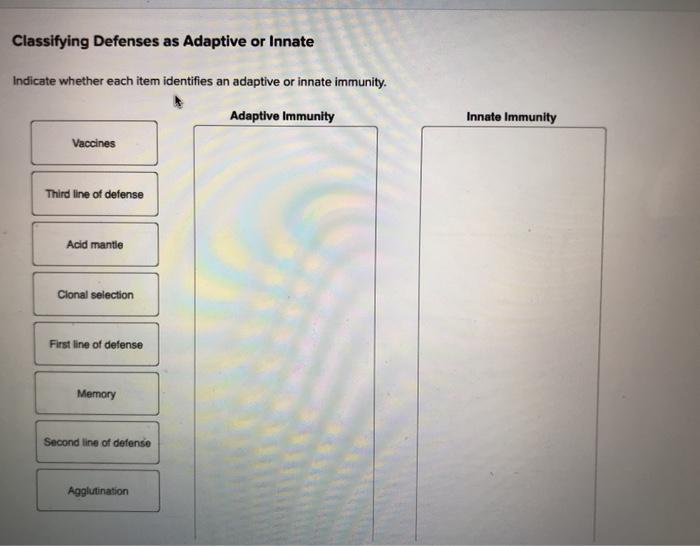Indicate whether each item identifies an adaptive or innate immunity. – The human immune system, a remarkable defense mechanism, operates through two distinct branches: innate immunity and adaptive immunity. While both are essential for maintaining health, their characteristics and functions differ significantly. This comprehensive guide delves into the intricacies of these immune responses, providing a clear understanding of their roles in protecting the body from pathogens.
Innate immunity, the body’s first line of defense, stands ready to respond immediately to foreign invaders. Its rapid and nonspecific reactions, such as inflammation and phagocytosis, offer immediate protection against a wide range of microorganisms. Adaptive immunity, on the other hand, is slower to develop but provides tailored responses to specific pathogens.
This highly specialized defense system remembers past encounters, enabling the body to mount faster and more effective attacks against future infections.
Innate Immunity

Innate immunity is the body’s first line of defense against infection. It is a non-specific response that is triggered by the presence of any foreign substance, regardless of its origin.
The characteristics of innate immunity include:
- Non-specific: Innate immunity does not distinguish between different types of pathogens.
- Immediate: Innate immunity is activated immediately upon exposure to a foreign substance.
- Effective against a broad range of pathogens: Innate immunity can recognize and respond to a wide variety of microorganisms, including bacteria, viruses, fungi, and parasites.
The types of innate immunity include:
- Physical barriers: Physical barriers, such as the skin and mucous membranes, prevent pathogens from entering the body.
- Chemical barriers: Chemical barriers, such as stomach acid and tears, kill or inhibit the growth of pathogens.
- Cellular barriers: Cellular barriers, such as macrophages and neutrophils, engulf and destroy pathogens.
- Cytokines: Cytokines are proteins that are released by immune cells in response to infection. They help to coordinate the immune response and recruit other immune cells to the site of infection.
Adaptive Immunity

Adaptive immunity is the body’s second line of defense against infection. It is a specific response that is tailored to each individual pathogen.
The characteristics of adaptive immunity include:
- Specific: Adaptive immunity can distinguish between different types of pathogens.
- Delayed: Adaptive immunity takes several days to develop after exposure to a foreign substance.
- Effective against specific pathogens: Adaptive immunity can recognize and respond to specific pathogens, such as a particular strain of bacteria or virus.
The types of adaptive immunity include:
- Antibodies: Antibodies are proteins that are produced by B cells. They bind to specific pathogens and help to neutralize them.
- T cells: T cells are white blood cells that recognize and destroy infected cells.
- Memory cells: Memory cells are long-lived cells that remember specific pathogens. They allow the body to mount a faster and more effective immune response upon re-exposure to the same pathogen.
Comparison of Innate and Adaptive Immunity: Indicate Whether Each Item Identifies An Adaptive Or Innate Immunity.
Innate and adaptive immunity work together to protect the body from infection. Innate immunity provides a rapid, non-specific response to infection, while adaptive immunity provides a more specific and targeted response.
The following table compares and contrasts innate and adaptive immunity:
| Characteristic | Innate Immunity | Adaptive Immunity | Examples |
|---|---|---|---|
| Specificity | Non-specific | Specific | Innate immunity: Macrophages engulf any foreign substance. Adaptive immunity: Antibodies bind to specific pathogens. |
| Timing | Immediate | Delayed | Innate immunity: Neutrophils respond immediately to infection. Adaptive immunity: T cells take several days to develop. |
| Effectiveness | Effective against a broad range of pathogens | Effective against specific pathogens | Innate immunity: Can recognize and respond to a wide variety of microorganisms. Adaptive immunity: Can recognize and respond to specific pathogens, such as a particular strain of bacteria or virus. |
| Memory | No memory | Memory | Innate immunity: Does not remember previous infections. Adaptive immunity: Memory cells remember specific pathogens and allow the body to mount a faster and more effective immune response upon re-exposure to the same pathogen. |
Examples of Innate and Adaptive Immunity

Examples of innate immunity include:
- The skin and mucous membranes prevent pathogens from entering the body.
- Stomach acid and tears kill or inhibit the growth of pathogens.
- Macrophages and neutrophils engulf and destroy pathogens.
- Cytokines help to coordinate the immune response and recruit other immune cells to the site of infection.
Examples of adaptive immunity include:
- Antibodies bind to specific pathogens and help to neutralize them.
- T cells recognize and destroy infected cells.
- Memory cells remember specific pathogens and allow the body to mount a faster and more effective immune response upon re-exposure to the same pathogen.
Questions Often Asked
What is the primary difference between innate and adaptive immunity?
Innate immunity is immediate and nonspecific, while adaptive immunity is slower to develop but provides tailored responses to specific pathogens.
Which type of immunity is responsible for recognizing and attacking specific pathogens?
Adaptive immunity
How do innate and adaptive immunity work together to protect the body?
Innate immunity provides immediate defense against a wide range of pathogens, while adaptive immunity develops targeted responses to specific infections, enhancing protection over time.